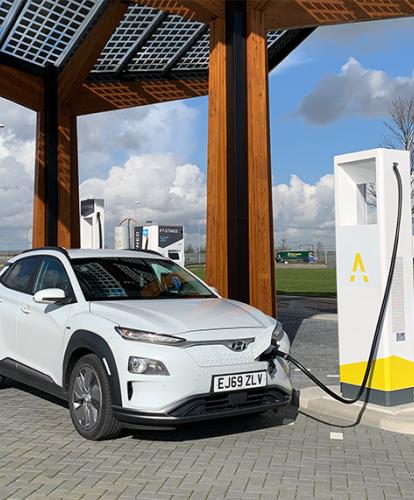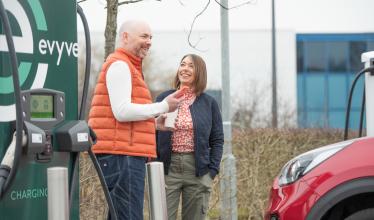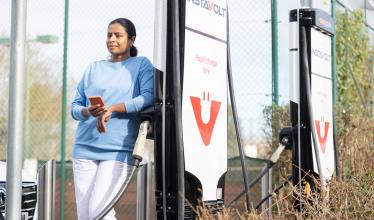Since Zapmap is one of the best places to find out about electric vehicles and EV charging in the UK, we thought we’d expand our knowledge a bit and find out what it’s like to drive and charge an electric car abroad.
As such, we planned a trip to coincide with the Geneva Motor Show. No flying, with a long drive to Switzerland and back to try out EV charging in a few of the UK’s nearest continental neighbours. Coronavirus put a halt to the show, but since it was cancelled at last notice, we decided to go ahead with the trip regardless – all before any lockdown measures were in place.
Instead of a run down to Geneva, most of which would have been through France, since the car and crossing were booked we decided to switch things around and take in a small tour of Europe. That way, we could tick off a greater number of countries and their EV charging infrastructure in a quick trip, and hopefully help potential intrepid travellers on their way.
The brief was simple, and in two parts; see how easy it is to not only drive a pure-electric car in Europe, but also discover what the charging systems are and how widespread the infrastructure is. It was partly a test of Europe’s EV charging set-up, and also a demanding test of the Hyundai Kona Electric. This is what happened in a whistle-stop Euro EV trip that saw us return home less than 48 hours after departing.
European EV adventure first leg: To the Chunnel
We set off in chilly conditions at 5:00 am on Monday 2nd March, bound for Folkestone and the Channel Tunnel. For the trip, Hyundai’s press office had lent us a Kona Electric, which is a car we’ve had a good experience of long-distance EV-ing before. The trip to Folkestone was just over 200 miles, and comfortably within the Kona Electric’s range on a single charge.
Having charged to more than 85% the night before, the car was displaying a range of 201 miles, but I was confident that the drive to Folkestone would be possible without stopping. Thanks to a slow spell from Reading through to the M3, we arrived at Ashford – a few miles from the Eurotunnel exit – for a charge.
There are a couple of rapid points at the Eurotunnel terminal, but the reports on Zapmap from users didn’t instil rock-solid confidence in them, and we didn’t know how long exactly we’d have to charge there before being called to the train.
Luckily, after a quick top-up on the Polar point selected at Ashford, we had more than 35% charge on getting through check-in; fortunate because we were directed straight through to departures and an earlier train than expected, skipping any chance to charge. As such, our plans shifted a little, but it was nothing too complicated and there was a plan in mind on boarding the train.
So far, so simple – but we had only tackled UK-based charging so far, and we’re pretty familiar with the market and infrastructure here!
European EV adventure second leg: Calais to Rely

We had always planned on using the Ionity network at least once on this trip, as it’s designed to help make pan-European EV travel simple. Prices may put a number of drivers off should they not have a manufacturer-backed subscription or similar, but the points are new, reliable, conveniently located, and often in significant numbers.
Initial plans were to head from Calais towards Reims, likely stopping off at Laon for a charge, but with a few Ionity locations along the Autoroute on the way down as back-up. Now with considerably less charge than expected – we’d thought at least a top-up to 80+% would be possible at Folkestone without catching an early train – the Ionity points at Rely services presented themselves as a great option.
Pulling into the services, we passed a Corri-Door charger that wasn’t working, before pulling up to the five Ionity charge points available – four ultra-rapid CCS units and one triple-header 50 kW charger. Here we charged from 13% to 60%, before getting back on the Autoroute. The charge was easy and fast – the Kona Electric spent much of the time charging at more than 75 kW – using a Newmotion card for access.
As an aside, the Corri-Door network is effectively France’s version of Ecotricity’s Electric Highway. It provides rapid chargers at a large number of locations and often in or near motorway routes. However, at the time of the trip, just about all rapid points were switched off, due to some sort of security issue.
European EV adventure third leg: Rely to Laon

The run down to Laon was smooth and simple, taking the Autoroute until we reached the small town. The stop here was picked for three key reasons. Firstly, it was initially the first stop in France before an earlier crossing put a halt to that. Secondly, it represented a good turning point in the trip, when we could head east away from France towards other countries. Thirdly – and almost most importantly – it was about time for lunch.
Having scouted beforehand, there was a Corri-door point not far from the Autoroute, which we had planned on being down and it subsequently was. The back-up came into play, with a Lidl rapid charger a little further into town, providing an ideal time to pick up a bite to eat.
Now on 8%, we aimed to make it through to Germany on a single charge, so wanted a good top-up with another 180 miles to go before the overnight stop.
The Lidl unit was the same hardware as those at the supermarket chain in the UK – triple-header 50 kW DC points that are easy to use. These were simple plug-and-go, with the only activation required being a prod of a button on the screen. No cards, no apps, just charge. A simple charging experience here saw us top up to 85% before leaving for the next leg, setting out across country towards the overnight stop.
European EV adventure fourth leg: Laon to Trier

Having essentially travelled largely on motorways thus far, it seemed only sensible to leave the main roads behind and head towards Germany via Luxembourg on country routes. It was a far more interesting driving experience, and it gave the Kona Electric time to build its predicted range back up.
Slowing down for corners and junctions gives a little brake energy recuperation, and the route is hillier too. The Kona Electric, despite showing a range of 185 miles when we left the charge point, arrived in Trier – 172 miles away – with 40 miles remaining.
I’d love to say that this trip was so well planned that we arranged accommodation that had an EV charge point for an overnight charge. We didn’t. Luckily, the hotel had a couple of Tesla destination chargers, which I only discovered after booking.
I was confident we could find a socket to plug in to at the hotel had there not been a proper charge point, and had scouted out some rapid chargers in Trier in case this wasn’t possible. But there was a non-Tesla specific unit at the overnight stop, and as such, charging was easy. Overnight the Hyundai was topped up to full charge before we climbed aboard for the second day.
European EV adventure fifth leg: Trier to Cologne

Having essentially reached the halfway point of the trip with everything having gone swimmingly, we left the hotel confident; though we have enough EV experience to know that it only takes a few mishaps for a long distance drive to go badly wrong.
However, Cologne had plenty of rapid charge points that we could see. We also had lots of range in the Kona Electric with which to get there – and further if needs be – with 226 miles indicated on the display, so it was with a confident prod of the right foot that we left the hotel and made our way through Germany’s oldest city.
Along the route to Cologne, we stopped at a charge point not because we needed the charge, but because we needed the experience of other networks’ systems. This trip was supposed to give us a good insight into European EV charging infrastructure, and so far, everything had been remarkably simple.
Because things had gone well, we only needed to stop at an EnBW unit along the way for five minutes, to make sure that we’d tried it out. There is an app for German residents to use, but it wasn’t available on our app store. As such, we used the contactless bank card system, and it worked fine – just as easily as in the UK.
We reached Cologne with more than 100 miles showing on the dashboard, and worked on similar principles to the previous day – a supermarket stop to pick up food and charge when we’d be stationary anyway. This time the target was a Kaufland on the edge of the city, not far from the Autobahn we’d picked up on approaching Cologne.
Here we hit our first snag of the trip – there was a car already charging. No bother, since there was no great push for time, so we hung around for about ten minutes and the driver moved off having done their shopping. We went and picked up lunch after plugging in and, like the French Lidl unit, it was familiar hardware with a plug-and-go operation. We got back to the car with more than enough charge for our next leg, covering 140 miles of German and Dutch roads.
European EV adventure sixth leg: Cologne to Holland

Heading away from Germany and turning back to Calais, we ventured into one of the world’s best prepared countries for EV charging – the Netherlands. Early legislation stating that interoperability is mandatory means that the many, many charge points available in the country can be used with just about any card you can lay your hands on.
Newmotion is a huge player in the market, which is why we had one up our sleeve for the trip, and we’ve used it in the UK; so of course we ignored it completely and headed to a Fastned EV charging hub to use their app.
There are a handful of Fastned units in the UK, with more sites planned. We hope they expand quickly across the UK as their hubs are lovely. The app is easy to use, and in typically prepared fashion, we’d forgotten to download and register before arriving. It’s good consumer testing though, and it only took a few minutes to do this on the hop.
A large solar canopy over the points is stylish, protects you a little from the elements – though it was nice weather when we arrived – and is easy to see from the motorway, let alone when you drive into the service station. The charge points are all ultra-rapid or rapid, and easy to use. It was a very pleasant charging experience, and one that I hope to repeat in the UK soon. A good charge meant we knew we’d have enough to not only make it back to Calais, but also venture into England if required.
European EV adventure seventh leg: Holland to Calais

An easy run through Holland and into Belgium saw another need to charge. Again, this wasn’t because we needed the miles, but because we needed the experience of other countries’ systems. This time, we stopped at a service station for an Allego charge point. The operation was easy, and there were no issues for the five minutes we spent charging. The app is somewhat over complicated, so we used an RFID card instead.
From there, it was a smooth run back to Calais, where we arrived around five hours early for the train. This was ‘sort-of’ planned, in that we made sure there was plenty of time to make it back to the terminal should any problems have presented themselves during the trip. With the chance of dropped charges, units out of action, or blocked charge points – either in use or ICE’d – there was the chance of not just one, but multiple hold-ups along the way.
Except there weren’t any. Everything went so smoothly in Europe that we were simply very, very early. It was a good job really since the charge points at the Eurotunnel terminal were anything but rapid. They charged at around half the possible 50 kW. Still, with plenty of time available, we had a decent charge before boarding the train.
European EV adventure eighth leg: Folkestone to Monmouth

Having had it all plain sailing in Europe, typically we hit issues back on home soil with a succession of motorway closures late at night. It made the run back to south east Wales far trickier then it needed to be, but there were no issues really. Because of the cold and increased rush to get back home, we decided to stop for a brief top-up to make sure of making it back in comfort.
Thanks to the road closures, and no planned stop, we had a quick look at Zapmap and decided upon the ultra-rapid Polar points at Bagshot. A short stop gave us plenty of charge for the homeward leg, and pulled up at the front door almost exactly 40 hours after leaving it. We’d travelled 1,195 miles and charged 10 times – though two charges were completely arbitrary, and another two were buffers for a more relaxing trip. Everything had gone swimmingly, and it must be said that, with a little planning, it’s remarkably easy to travel in Europe in an EV.

It must also be said that we really wished Zapmap was available across Europe – though that’s a huge project and there are plenty of other services to offer in the UK first. The combination of multi-network points mapping, dynamic data on many units, and Zap-Chats from users for another layer of information would have been useful on the trip, and made me appreciate how much I rely on Zapmap – regardless of working for the company.
The other benefit was the Hyundai Kona Electric. Having had success on an overnight distance challenge, we were confident of the Kona Electric’s long-range capabilities, and that confidence is now rock-solid. Despite chilly weather and regular fast runs, the possible range never dipped below a realistic 230 miles on a charge, and that’s essentially a worst-case scenario.
It easily gets much closer to 300 miles on a charge, and the efficiency is simple to maintain thanks to selectable regen levels. We covered almost 1,200 miles, spending more than 22 hours of our 40 hour trip in the driving seat, and returned home with an average efficiency of 3.5 miles per kWh – impressive considering we were on fast roads for much of the trip.
As such, we can confidently say it’s good to drive, plenty practical enough for a trip abroad for a couple of adults, and proved comfortable even having racked up the miles in a short space of time. It can also charge very quickly; not premium EV quick, but we still saw 70+ kW going into the Kona Electric regularly. It was a fantastic car for the trip, and removed much of the challenge in an instant.

In short, the Kona Electric was a great EV for a mini European tour, and the charging infrastructure in each of the five continental countries we drove through is easy enough to use and reliable at those points we came across. We tried to use a mixture of motorway and town-based charge points, and got a good feel for what’s around – or as much as you can in a day and a half spent on the continent. It’s encouraging, and if you’re happy enough covering long distances in the UK, a little research – not any more really than a petrol- or diesel-powered European jaunt – will see you comfortably capable of travelling across Europe. Bon voyage.



